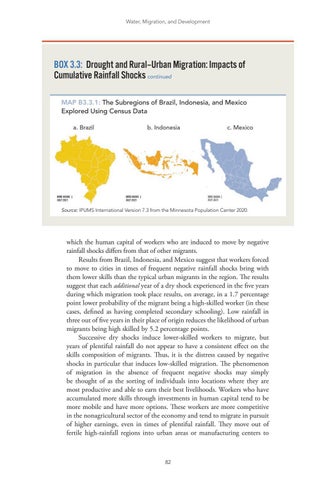Water, Migration, and Development
BOX 3.3: Drought and Rural–Urban Migration: Impacts of Cumulative Rainfall Shocks continued MAP B3.3.1: The Subregions of Brazil, Indonesia, and Mexico Explored Using Census Data
Source: IPUMS International Version 7.3 from the Minnesota Population Center 2020.
which the human capital of workers who are induced to move by negative rainfall shocks differs from that of other migrants. Results from Brazil, Indonesia, and Mexico suggest that workers forced to move to cities in times of frequent negative rainfall shocks bring with them lower skills than the typical urban migrants in the region. The results suggest that each additional year of a dry shock experienced in the five years during which migration took place results, on average, in a 1.7 percentage point lower probability of the migrant being a high-skilled worker (in these cases, defined as having completed secondary schooling). Low rainfall in three out of five years in their place of origin reduces the likelihood of urban migrants being high skilled by 5.2 percentage points. Successive dry shocks induce lower-skilled workers to migrate, but years of plentiful rainfall do not appear to have a consistent effect on the skills composition of migrants. Thus, it is the distress caused by negative shocks in particular that induces low-skilled migration. The phenomenon of migration in the absence of frequent negative shocks may simply be thought of as the sorting of individuals into locations where they are most productive and able to earn their best livelihoods. Workers who have accumulated more skills through investments in human capital tend to be more mobile and have more options. These workers are more competitive in the nonagricultural sector of the economy and tend to migrate in pursuit of higher earnings, even in times of plentiful rainfall. They move out of fertile high-rainfall regions into urban areas or manufacturing centers to
82



